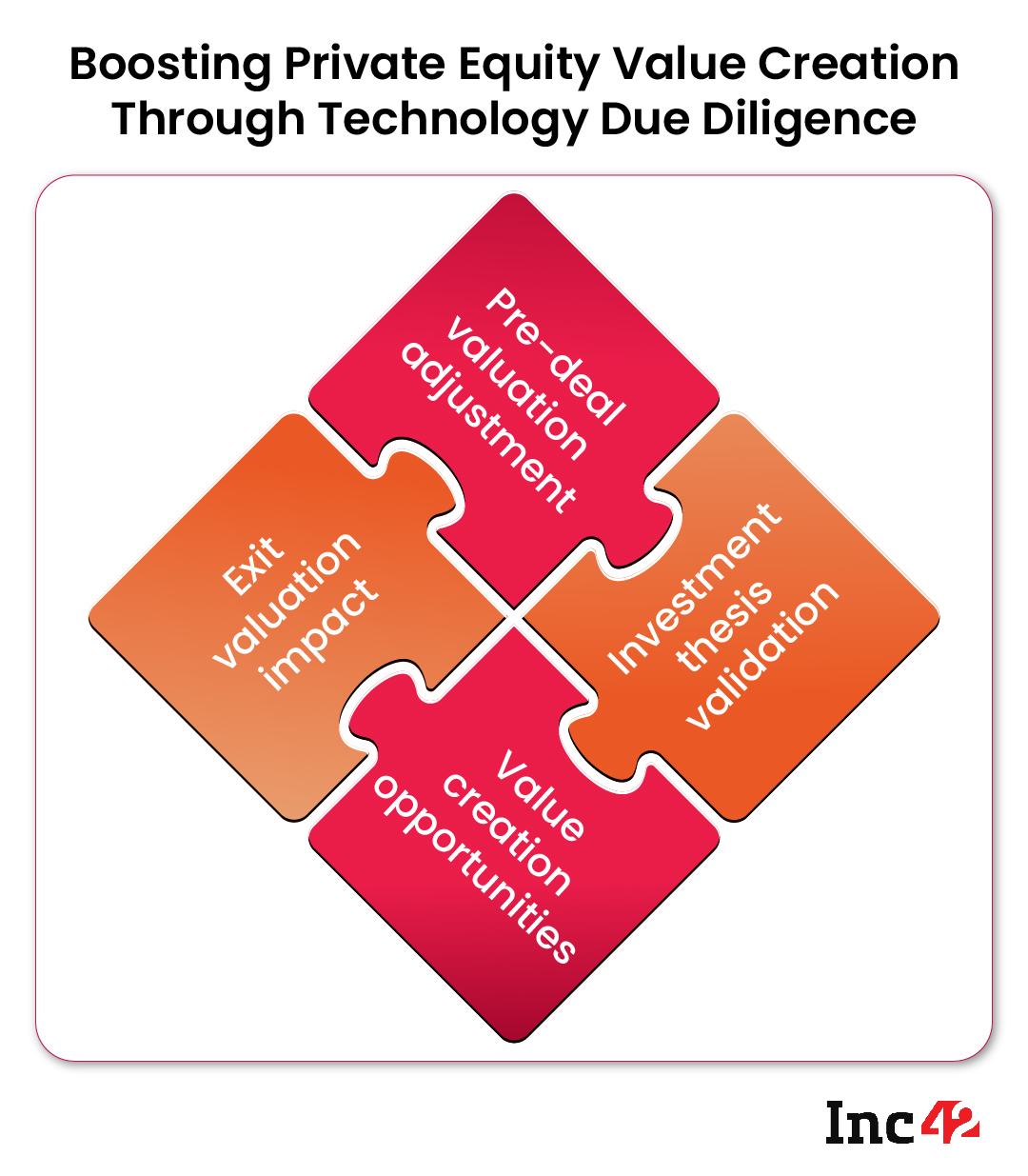The year 2021 was a record year for private equity (PE), with deal volume exceeding $1 Tn for the first time
To provide a meaningful analysis of a startup, the output of technology diligence should be linked to the output of commercial and financial diligence
PE firms should be armed with an innovative technology due diligence process that validates the investment thesis through a digital lens
The year 2021 was a record year for private equity (PE), with deal volume exceeding $1 Tn for the first time. This is nearly double the amount from the previous year. The majority of private equity firms prefer technology companies or companies with a tech-enabled business model to non-technology companies.
Value creation has always been central to achieving higher returns on private equity investments. The value creation approach for technology or technology-enabled companies goes beyond EBITDA improvement through cost-cutting measures. During each such tech investment, the PE firm examines the potential of value creation based on multiple touchpoints.
This includes revenue growth supported by a scalable digital strategy, data-driven growth capabilities supported by advanced analytics, cost transformation driven by a reduction of technical complexity/debt, and operational efficiencies through better IT sourcing arrangements. The ability to accelerate these value creation goals in the immediate post-close period will be critical for unlocking value from the investments.
In the diligence phase for such investments, a technological perspective is required in addition to commercial and financial due diligence. To provide a meaningful analysis of a startup, the output of technology diligence should be linked to the output of commercial and financial diligence.
 Reorient Technology Due Diligence
Reorient Technology Due Diligence
PE firms should be armed with an innovative technology-driven due diligence process that validates the investment thesis through a digital lens. The traditional approach of checking a box to ensure that no significant technological red flags exist is no longer sufficient to support the deal thesis. To determine true value, private equity firms must generate deeper technical insights about potential investments.
Due diligence in technology should help validate how technology is aligned to support core business operations, as well as how it will help drive future growth in terms of both top-line revenue expansion and bottom-line cost savings opportunities. The emphasis of technology diligence is shifting away from risk mitigation and toward value creation.
Besides identifying technology red flags that will aid in pre-deal decisions or valuation adjustments, tech due diligence should also identify the target company’s immediate and long-term improvement opportunities for value creation.

Technology Red Flags
The first output aids in assessing the IT risk profile, which may have an impact on pre-deal valuation. The emphasis is on historical factors such as IT architecture complexity, security breaches, code quality review, IT team expertise, and cost benchmarking in IT.
Technology Levers Towards Enabling Revenue Growth
The second output validates the investment thesis by focusing on the target’s digital capabilities. To support revenue growth projections, the existing digital strategy should be evaluated for scalability. Target should be able to generate insights for the management in areas such as sales, pricing, and manufacturing through its data-driven analytics capabilities to support business growth.
Technology Levers Towards Operational Efficiencies
The third output is concerned with identifying post-deal value creation opportunities that will have an impact on the exit valuation. IT operational efficiencies equate to long-term cost efficiencies, such as reduced technical complexity/debt via open architecture supported by a standardized set of technology capabilities. IT operational efficiencies are also achieved by lowering IT supplier costs by optimizing sourcing arrangements among portfolio companies.
How Target Revamped Its Current Tech To Achieve A Higher Exit Valuation
One such scenario is when a private equity firm wanted to validate the deal thesis by assessing the effectiveness of Target’s current technology landscape to support future growth and profitability. Future IT cost projections as a percentage of the gross written premium (GWP) was developed as part of a revised technology due diligence.
The pre-deal valuation had to be adjusted to account for the higher anticipated future IT costs because the derived IT cost as a percentage of GWP exceeded the target’s internal projection. It was advised to swap out the current on-premise Policy Admin System (PAS) with a Software-as-a-Service (SaaS) solution to support the 5X growth projections stated in the deal thesis.
Furthermore, it was recommended that the current data warehouse system and datacenters be replaced with cloud-based solutions to support a higher exit valuation when considering post-deal value creation opportunities.
Traditional Risk Assessment Needs To Change
Technology due diligence for private equity should shift from a traditional risk assessment exercise to an innovative approach that identifies value creation levers during the due diligence phase. Along with providing a perspective on the target company’s risks and challenges, it should also validate how technology can support the deal rationale.
The results of technology diligence should assist in overall commercial and financial diligence in identifying valuation adjustments during the pre-deal phase as well as potential value creation opportunities to improve post-deal exit valuation.





![Read more about the article [App Fridays] This startup-centric hiring platform directly connects jobseekers with founders and CXOs](https://blog.digitalsevaa.com/wp-content/uploads/2021/09/Hirect-01-1631105442261-300x150.png)



